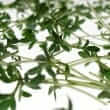Background
- Garden cress (Lepidium sativum) has been consumed in salads and sandwiches since ancient times. Western Asian, Mediterranean, and Indian cultures have used the seeds of garden cress to cause laxative effects, induce labor, or relieve pain. The roots have been used treat syphilis and tenesmus (urge to evacuate the stools). The leaves have been used as an antibacterial agent, a diuretic (increases urination), and a stimulant, as well as to treat liver disorders and scurvy (disease from vitamin C deficiency).
- At this time, there is a lack of evidence supporting the efficacy of garden cress for any condition. However, various traditional uses exist.
- Limited reports state that garden cress is useful for treating several illnesses, including colic, "viscous humors," and leprosy. Garden cress may relieve the body's allergic responses to insect bites. It has also been used as a fumigant (pest control substance), an anthelmintic (to eliminate parasitic worms), and an aphrodisiac. Also, garden cress may be useful in preventing hair loss and "renal cooling," and stimulating the appetite.
- According to Ayurvedic medicine, garden cress displays the following properties: hot, bitter, tonic, and aphrodisiac. It is also useful in the treatment of dysentery, pain in the abdomen, blood and skin disorders, injuries, tumors, and eye diseases. Garden cress may stimulate the production of breast milk and prevent postnatal complications.
- The traditional medicines of Saudi Arabia and other Arab countries use the garden cress plant and seeds for healing bone fractures, although there is little evidence to support the effectiveness of this use.
References
- Czimber G. Therapeutic effect and production of garden cress (Lepidium sativum L.). Gyogyszereszet (Hungary) 1988;32:79-81.
- Diwakar BT, Dutta PK, Lokesh BR, and Naidu KA. Bio-availability and metabolism of n-3 fatty acid rich garden cress (Lepidium sativum) seed oil in albino rats. Prostaglandins Leukot.Essent.Fatty Acids 2008;78(2):123-130. View Abstract
- Eddouks M, Maghrani M. Effect of Lepidium sativum L. on renal glucose reabsorption and urinary TGF-beta 1 levels in diabetic rats. Phytother.Res 2008;22(1):1-5. View Abstract
- Gokavi SS, Malleshi NG, and Guo M. Chemical composition of garden cress (Lepidium sativum) seeds and its fractions and use of bran as a functional ingredient. Plant Foods Hum Nutr 2004;59(3):105-111. View Abstract
- Juma AH. The effects of Lepidium sativum seeds on fracture-induced healing in rabbits. MedGenMed. 2007;9(2):23. View Abstract
- Kassie F, Rabot S, Uhl M, Huber W, Qin HM, Helma C, Schulte-Hermann R, and Knasmuller S. Chemoprotective effects of garden cress (Lepidium sativum) and its constituents towards 2-amino-3-methyl-imidazo[4,5-f]quinoline (IQ)-induced genotoxic effects and colonic preneoplastic lesions. Carcinogenesis 2002;23(7):1155-1161. View Abstract
- Lhoste EF, Gloux K, De Waziers I, Garrido S, Lory S, Philippe C, Rabot S, and Knasmuller S. The activities of several detoxication enzymes are differentially induced by juices of garden cress, water cress and mustard in human HepG2 cells. Chem Biol Interact. 12-7-2004;150(3):211-219. View Abstract
- Maghrani M, Zeggwagh NA, Michel JB, and Eddouks M. Antihypertensive effect of <it>Lepidium sativum</it> L. in spontaneously hypertensive rats. Journal of Ethnopharmacology (Ireland) 2005;100:193-197.
- Maleki A, Zarasvand MA. Heavy metals in selected edible vegetables and estimation of their daily intake in Sanandaj, Iran. Southeast Asian J Trop.Med Public Health 2008;39(2):335-340. View Abstract
- Regassa A. The use of herbal preparations for tick control in western Ethiopia. J S Afr Vet.Assoc 2000;71(4):240-243. View Abstract
- Robinson B, Duwig C, Bolan N, Kannathasan M, and Saravanan A. Uptake of arsenic by New Zealand watercress (Lepidium sativum). Sci Total Environ 1-1-2003;301(1-3):67-73. View Abstract
- Smolinska B, Cedzynska K. EDTA and urease effects on Hg accumulation by Lepidium sativum. Chemosphere 2007;69(9):1388-1395. View Abstract
- Spera G, Cardone F, Cherubini G, and Leandri A. Natural specific radioactivity in different soils. Transfer in the soil plant food chain. Commun Agric Appl.Biol Sci 2003;68(4 Pt B):817-826. View Abstract
- Steinkellner H, Rabot S, Freywald C, Nobis E, Scharf G, Chabicovsky M, Knasmuller S, and Kassie F. Effects of cruciferous vegetables and their constituents on drug metabolizing enzymes involved in the bioactivation of DNA-reactive dietary carcinogens. Mutat.Res 9-1-2001;480-481:285-297. View Abstract
- Wright CI, Van-Buren L, Kroner CI, and Koning MM. Herbal medicines as diuretics: a review of the scientific evidence. J Ethnopharmacol. 10-8-2007;114(1):1-31. View Abstract







